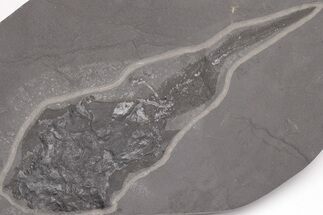This Specimen has been sold.
Rhynie Chert - Early Devonian Vascular Plant Fossils
This is a cut and polished slice of Rhynie chert which provides evidence of some of the earliest colonization of land by plants, some 410 million years ago. Cross sections of these plants can be seen in the chert often with cell and tissue structure still visible under magnification. Comes in a riker mount display case.
The Rhynie Chert beds in Aberdeenshire in the north of Scotland are important fossil sites that reveal much about the evolution of life during the Early Devonian, approximately 410 million years old. At the time the Earth's geography was an aggregate mass of land in the Southern Hemisphere with smaller continents in the equatorial region. Europe resided near the equator, so the Rhynie Chert beds were in a tropical to subtropical climate and consisted mostly of flatlands and short-lived shallow polls of fresh water.
Rhynie fossils are preserved when mineral sediments settled around and on top of the organic matter and compressed them. Over time the fossils were formed through silica replacement of the organic material. The silica deposits may have originated from the hot springs and volcanic activity common in the Devonian and around the Rhynie fossil beds. The result is a preservation in chert, a kind of finely crystalline quartz, which occurs in veins throughout the rest of the surrounding rocks.
The Rhynie Chert beds in Aberdeenshire in the north of Scotland are important fossil sites that reveal much about the evolution of life during the Early Devonian, approximately 410 million years old. At the time the Earth's geography was an aggregate mass of land in the Southern Hemisphere with smaller continents in the equatorial region. Europe resided near the equator, so the Rhynie Chert beds were in a tropical to subtropical climate and consisted mostly of flatlands and short-lived shallow polls of fresh water.
Rhynie fossils are preserved when mineral sediments settled around and on top of the organic matter and compressed them. Over time the fossils were formed through silica replacement of the organic material. The silica deposits may have originated from the hot springs and volcanic activity common in the Devonian and around the Rhynie fossil beds. The result is a preservation in chert, a kind of finely crystalline quartz, which occurs in veins throughout the rest of the surrounding rocks.
SPECIES
Various
LOCATION
Rhynie, Aberdeenshire, Scotland
FORMATION
Rhynie Chert
SIZE
2.4" wide
CATEGORY
ITEM
#25799
We guarantee the authenticity of all of our specimens.
 Reviews
Reviews













